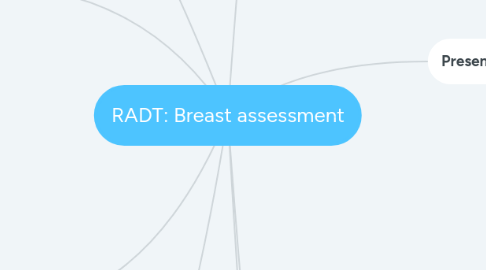
1. Prognosis:
1.1. Predict
2. Aetiology and Epidemiology
2.1. Inherited
2.1.1. Inherit BRCA (BRCA1 OR BRCA2)
2.1.1.1. carried by 1 in 450 women
2.1.2. Can have genetic testing
2.1.3. patient has no family history
2.2. Epidemiology
2.2.1. 2.1 million women diagnosed every year
2.2.2. 78% survival rate for 10 years or more
2.2.3. 23% are preventable
3. Risk factors:
3.1. Alcohol
3.1.1. Patient drinks alcohol occasionally
3.1.2. contemporary drinking - within 5 years is directly linked to breast cancer risk
3.1.2.1. most pronounced with women with advanced disease
3.1.2.1.1. who drank > 14 drinks a week
3.1.2.1.2. based on a study of women aged 20-44 with in-situ or invasive disease
3.1.2.1.3. Study lacks at it was predominantly done on white people - 79% white, 15% black and 6% other races, so may be argued that it isn't representable of all races
3.1.2.1.4. risk increased 70-80% amongst most frequent drinkers = >14
3.1.3. acts at a late stage in cancer carcinogensis
3.2. obesity
3.2.1. 8% decrease risk per 5 unit body mass index BMI increase
3.3. Endogenous factors
3.3.1. contraceptives
3.3.1.1. 14% increase risk for 10 year increment of use
3.3.1.2. 7% increase per 5 year use
4. Breast anatomy
5. Patient details:
5.1. Gender
5.1.1. Female
5.2. Age
5.2.1. 36
5.2.1.1. Pre-menopausal
5.3. Married
5.4. no kids
6. Presentation
6.1. self detection of breast lump
6.1.1. Has a clinical examination first
6.1.1.1. Results
6.1.1.1.1. cT = 1c
6.1.1.1.2. cN= 0
6.1.1.1.3. cM= X
6.1.2. Then ultrasound because patient is < 40 years
6.1.2.1. Breast tissue is too dense for mammogram- may be difficult to distinguish abnormalities.
6.1.2.1.1. Many areas of fibrous and glandular tissue
6.1.2.2. showed a posteriorly located irregular hypoechoic mass 13mm with malignant features.
6.1.2.2.1. Hypoechoic = more dense or solid than usual
6.1.2.3. Several morphological lymph nodes seen in right axilla.
6.1.2.3.1. = normal axilla lymph nodes
6.1.2.4. U5 = findings highly suspicious of malignancy
6.1.2.5. A1= normal lymph nodes
6.1.2.5.1. Nearby lymph nodes
6.1.3. Bilateral mammograms peformed
6.1.3.1. Moderately dense glandular pattern seen
6.1.3.1.1. No prior images for comparison.
6.1.3.2. There is a low density partially defined 14mm opacity located at the nipple level on the right MLO view with asymmetry in the right inner breast which may correspond
6.1.3.3. RIGHT BREAST- M3= Intermediate results- small likelihood of malignancy
6.1.3.4. LEFT BREAST- M2= Benign findings
6.1.3.5. Against NICE guidelines, Mammogram performed due to suspected malignancies in US
6.1.4. Ultrasound guided core biopsy
6.1.4.1. right inner breast 3 o’clock
6.1.4.2. 5mls of plain lidocaine was infiltrated
6.1.4.2.1. Anaestetic
6.1.4.3. 3 samples obtained
6.1.4.4. Right breast wide bore needle 14g inner
6.1.5. Referral times;
6.1.5.1. 2 weeks referral time for appointment due to having an unexplained lump over 30
6.1.5.1.1. according to NICE guidelines
6.2. Biopsy results
6.2.1. Clinical details
6.2.1.1. P3 mass in inner right breast
6.2.1.2. U5
6.2.1.3. 13mm mass M3
6.2.2. Microscopy
6.2.2.1. appearance of grade 2 invasive ductal carcinoma
6.2.2.1.1. moderately differentiated
6.2.2.2. B5b = indicates malignant invasive
6.2.2.3. calsifications absent
6.2.3. Invasive grade
6.2.3.1. Grade 2
6.2.3.1.1. Overall, moderately differentiated
6.2.3.2. T: 3
6.2.3.2.1. Tubular differentiation
6.2.3.2.2. < 10%
6.2.3.3. p:3
6.2.3.3.1. Nuclear pleomorphism
6.2.3.3.2. Cells with vesicular nuclei, prominent nucleoli, marked variation in shape and size
6.2.3.4. M:1
6.2.3.4.1. Mitosis Count
6.2.3.4.2. <7 mitosis per 10 high power fields
6.2.4. Vascular invasion
6.2.4.1. present
6.2.4.1.1. cancer cells have spread to nearby blood vessels or lymph channels
6.2.4.1.2. Increased risk of metastatic disease
6.2.4.1.3. usually seen at periphery of invasive carcinoma
6.2.5. Hormone receptors
6.2.5.1. Using immunohistochemistry test (IHC)
6.2.5.1.1. Threshold Varys at each practise, but usually >10% to be +
6.2.5.2. Results
6.2.5.2.1. ER 0 = negative
6.2.5.2.2. PR 0 = negative
6.2.5.2.3. HER-2 = 3+
7. Treatment options
7.1. Surgery
7.1.1. according to predict
7.1.1.1. Breast only
7.1.2. Why?
7.1.2.1. Size 1cm<X<2cm
7.1.2.2. Boost
7.1.2.2.1. Less than 50 years of age
7.1.2.2.2. HER-2 +
7.1.2.2.3. LVI present
7.1.3. No mastectomy
7.1.3.1. due to tumour being relatively small
7.2. Post surgery radiotherapy
7.2.1. due to HER-2 +
7.3. neo-adjuvant chemo
7.3.1. Due to being HER-2 positive
7.3.2. 3rd gen or 2nd?
7.3.2.1. 3rd generation 5 year survival rate = 89%
